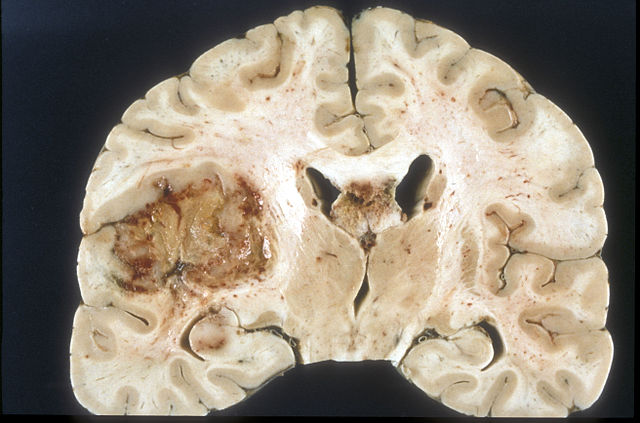![Glioblastoma accounts for almost half of all brain cancers. [Sbrandner/Wikimedia]](https://genengnews.com/wp-content/uploads/2018/10/Sep11_2018_Wikimedia_GlioblastomaMacro2291232517.jpg)
Glioblastoma accounts for almost half of all brain cancers. [Sbrandner/Wikimedia]
Scientists from the Virginia Tech Carilion Research Institute say a gene involved in the body's circadian rhythms is a potential target for therapies to help patients with glioblastoma.
Their discovery (“Casein Kinase 1 Epsilon Regulates Glioblastoma Cell Survival”), published in Scientific Reports, points to a subtype of a particular gene that apparently is enabling the survival of cancer cells, although it is more commonly associated with circadian rhythms.
“Glioblastoma is the most common malignant brain cancer, with a dismal prognosis. The difficulty in treating glioblastoma is largely attributed to the lack of effective therapeutic targets. In our previous work, we identified casein kinase 1 ε (CK1ε, also known as CSNK1E) as a potential survival factor in glioblastoma. However, how CK1ε controls cell survival remains elusive and whether targeting CK1ε is a possible treatment for glioblastoma requires further investigation. Here we report that CK1ε was expressed at the highest level among six CK1 isoforms in glioblastoma and enriched in high-grade glioma, but not glia cells. Depletion of CK1ε remarkably inhibited the growth of glioblastoma cells and suppressed self-renewal of glioblastoma stem cells, while having limited effect on astrocytes,” write the investigators.
Most patients do not live more than about 15 months after diagnosis. About 90% of patients who live longer than two years develop recurrent tumors, for which an additional brain surgery is often not a treatment option. The disease, which accounts for almost half of all brain cancers, recently claimed the life of U.S. Sen. John McCain.
“CK1ε deprivation activated β-catenin and induced apoptosis, which was further counteracted by knockdown of β-catenin. The CK1ε inhibitor IC261, but not PF-4800567, activated β-catenin and blocked the growth of glioblastoma cells and glioblastoma stem cells. Congruently, IC261 elicited a robust growth inhibition of human glioblastoma xenografts in mice. Together, our results demonstrate that CK1ε regulates the survival of glioblastoma cells and glioblastoma stem cells through β-catenin signaling, underscoring the importance of targeting CK1ε as an effective treatment for glioblastoma.”
“The world is desperately seeking new treatments for glioblastoma and no one has ever before pointed to this gene as a target upon which to base therapies,” said Zhi Sheng, Ph.D., an assistant professor at the Virginia Tech Carilion Research Institute, whose team pinpointed the gene from 20 suspects it had previously identified.
“We have found that inhibiting this gene may inhibit cancer stem cells from renewing themselves and differentiating into glioblastoma cells, which we suspect may be a hallmark of this very persistent cancer,” explained Dr. Sheng, who is also an assistant professor of Internal Medicine at the Virginia Tech Carilion School of Medicine. “More research is needed before a treatment can be designed, but our early, basic science results are promising.”
New therapies for glioblastoma patients are desperately needed, according to Dr. Sheng, who led the study. Dr. Sheng says the cancer can recur if only a few hundred glioblastoma stem cells survive after surgery, radiation therapy, and chemotherapy.
However, in their experiments, carried out in cell cultures and in a laboratory mouse model of glioblastoma as described in Scientific Reports, the researchers determined when an enzyme (Casein Kinase 1 Epsilon) produced by a member of the casein kinase 1 gene family is blocked, the proliferation of glioblastoma stem cells stops and tumor formation in mice is inhibited.
The researchers found evidence to show the enzyme is regulating the glioblastoma stem cells effectiveness at self-renewal, rather than differentiation.
“Blocking this gene effectively killed cancer stem cells,” noted Dr. Sheng who, along with colleagues, also evaluated two commercially available drugs that block casein kinase 1 gene from activating circadian rhythms, with one showing some potential for further investigation as a chemical inhibitor of glioblastoma stem cells.



